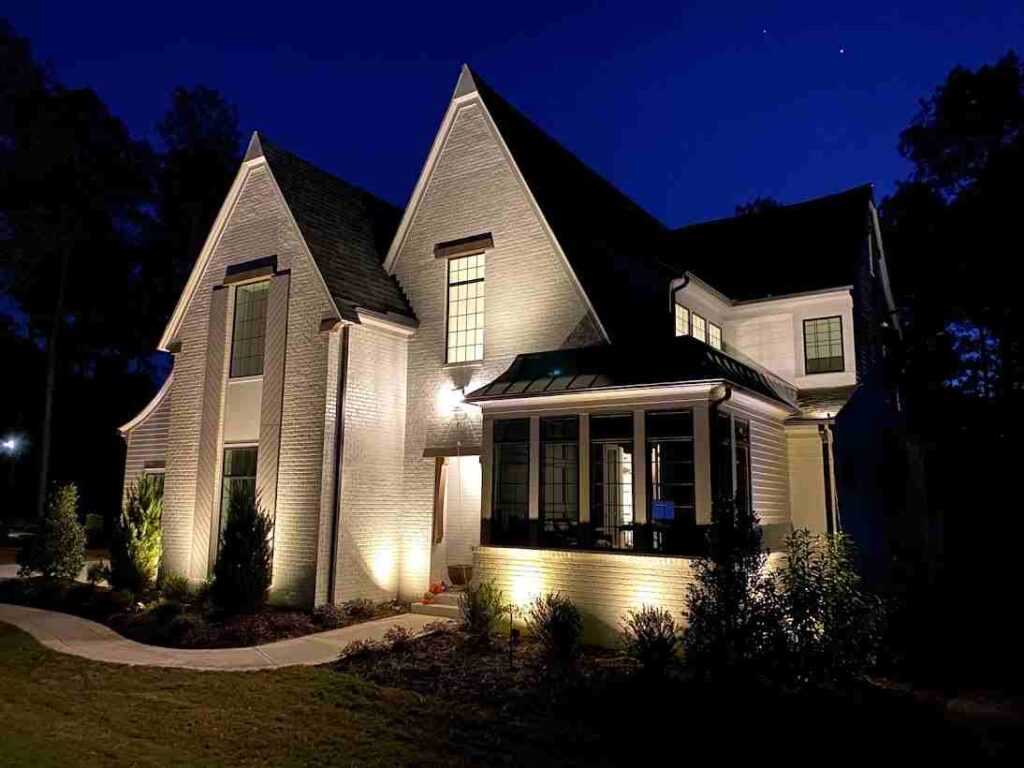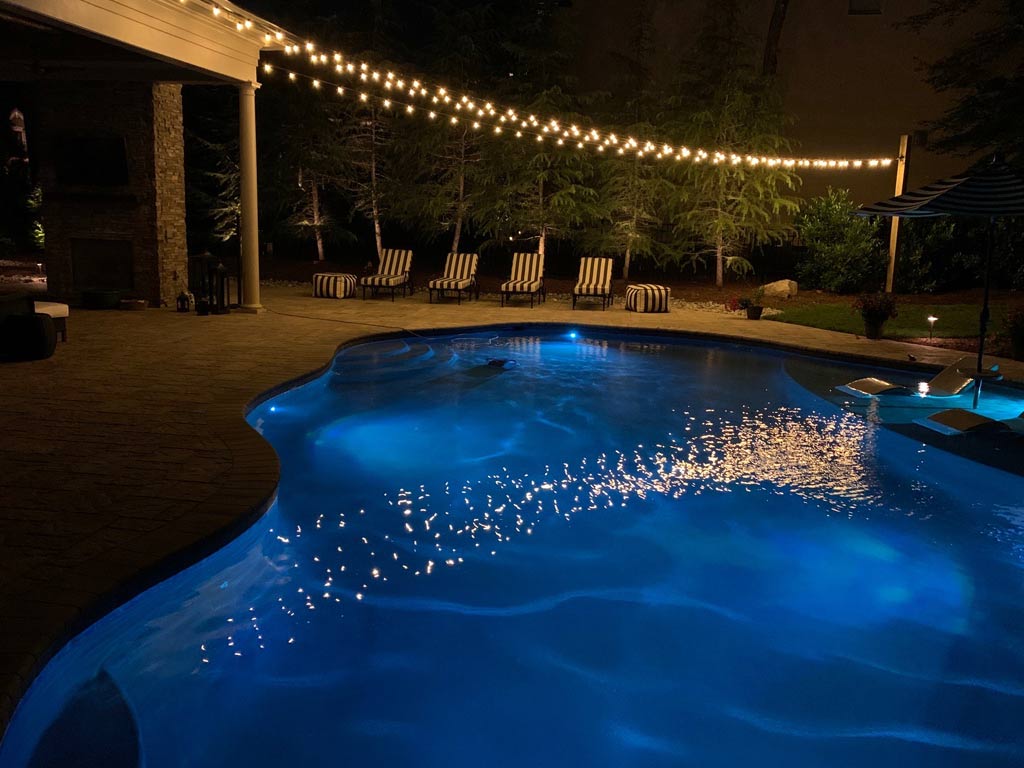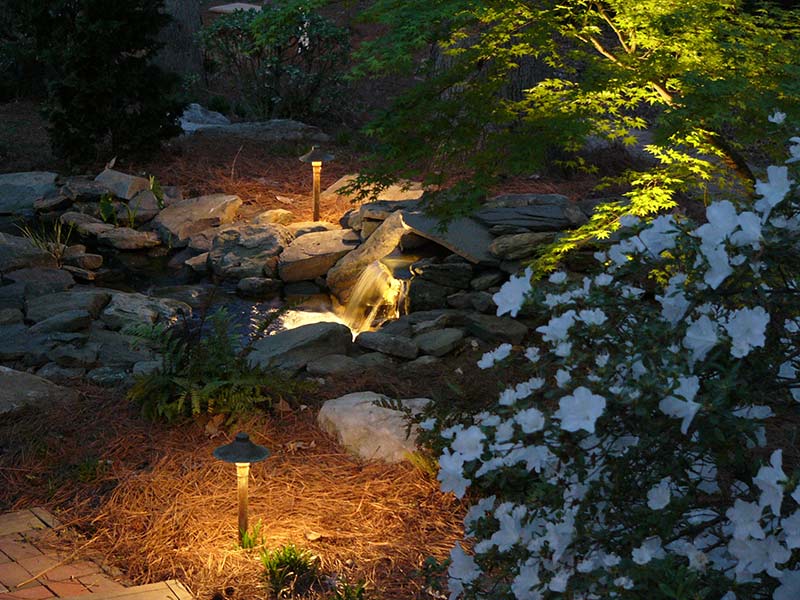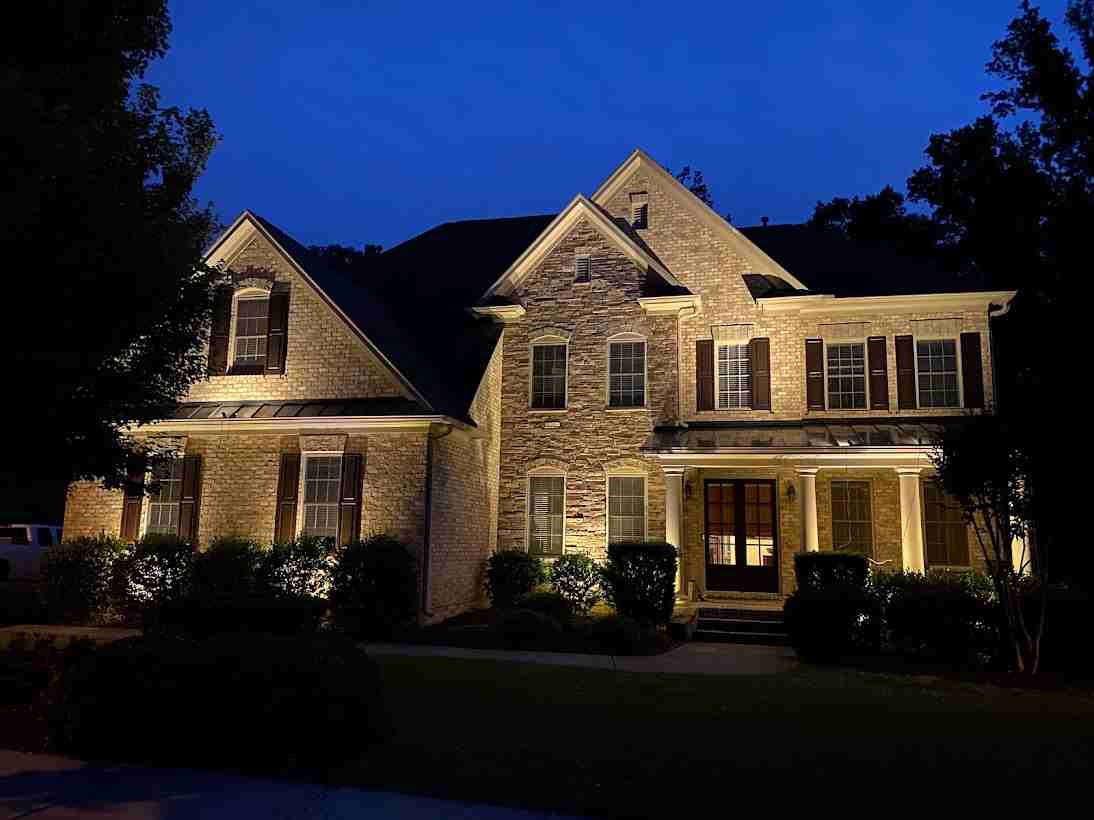If you have made the decision to hire an outdoor lighting company to install outdoor lighting for safety and ambiance at your home, you more than likely are doing some research about the options that are available. And, you are probably finding that there is a new vocabulary with specific terms relative to outdoor lighting that you may or may not be familiar with. To simplify the process of your research and aid in your understanding, our team at Carolina Outdoor Lighting has put together a guide to outdoor lighting terminology.
Low Voltage Lighting
Low-voltage lighting systems use a transformer to reduce normal line voltage. Normal line voltage is usually 120 or 277 volts, whereas low voltage lighting is 12 or 24 volts (most commonly only 12 volts!) This type of lighting is typically used in landscape, recessed, track, pendant, and display lighting applications. Low voltage lighting is used where it is challenging to run standard-voltage electrical conduit and wire or to save greatly on energy costs. The main limitation has to do with distance–you can only get low voltage so far from a transformer box, however, distance doesn’t become an issue in most residential circumstances.
Safety
Low voltage lighting is safer because the voltage from the transformer to the fixtures is less powerful than line voltage. When creating outdoor lighting, low voltage is more common because it circumvents having to bury wire underground to code.
Portability
Low voltage lighting is less permanent than standard line voltage lighting. Adding an additional fixture to a low voltage system is easy as long as there is enough power coming from the transformer to power the light.
Potential for Energy Savings
If you can maximize the voltage being reduced from the transformer, you potentially can get multiple fixtures powered and lit from the same voltage that would conventionally power one.
LED Lighting
A Light Emitting Diode (LED) is a semiconductor device, which can emit light when an electric current passes through it. Electrons in the semiconductor recombine with electron holes, releasing energy in the form of photons (energy packets).
An LED light uses much less energy (watt) to produce the same light output (lumen). As an example, an LED bulb uses only 2.5 watts to produce a light output of 115 lumens, while a traditional bulb uses 15 watts (6 times more energy) to produce the same lumen output.
Some advantages of LED lights are:
- Long lifespan
- Energy efficiency
- Improved environmental performance
- Ability to operate in cold conditions
- No heat or UV emissions
- Design flexibility
- Instant lighting and the ability to withstand frequent switching
- Low voltage operation
Lumens
Simply put, lumens measure the amount of light you get from a bulb. One lumen equals the brightness of 1 candle, so 1000 lumens has the brightness of 1000 candles. 1000 lumens is a very good level of light for LED. A lot of the lumen requirements depend on where the lighting is placed and the main purpose of the light. If you place a light in a darker area, you may require more lumens. If you want the light itself to not be as bright, invest in a bulb that emits fewer lumens.
Below is a list of recommended LED lumens for specific outdoor lighting:
- Landscape lights: 50-300
- Hardscape lights (on walls): 50-185 lumens
- Step lights: 12-100 lumens
- Path lights: 100-200 lumens
- Landscape spotlights: 120 lumens
- Lamp posts: 120-180 lumens
- Pond/pool lights: 200-400 lumens
- Motion sensor lights: 300-700 lumens
- Floodlights: 700-1300 lumens
Spread
Spread, also referred to as “beam spread,” is the amount of space a light covers from different distances. Put another way, beam spread refers to the measurement of how a light source causes a light to spread. The spread can be used to determine how wide or narrow a beam of light is going to be. As light moves away from a reflectorized light source, it spreads out and becomes less intense. By multiplying the angle of the beam by 0.018, and then by the distance, one can determine the beam spread.
Different types of reflector lamps offer various beam spreads; therefore, for example, it’s important to distinguish between floodlights and spotlights. In general, a spotlight will have a beam that is less than 45 degrees wide, while a floodlight will have a beam that can spread up to 120 degrees.
There are a few ways to incorporate the concept of beam spread into your landscaping. If you want lights to highlight specific objects, you may want to use a narrower spotlight that projects a more precise beam. On the other hand, if you want to illuminate a tree or an even larger area of land, you would choose a floodlight, which provides a greater beam spread and can illuminate larger spans.
Uplighting
Uplighting is lighting that is placed to throw illumination upward. This is a popular lighting effect created by strategically placing lighting fixtures on the ground and pointing them up. It is an effective way to dramatically improve the ambiance of a space and create depth in the landscaping at night.
Because uplighting draws the eye up, when used in landscaping, you can have beautifully lit trees that make the leaves and branches become a focus. Uplighting is also used to emphasize the architecture of a house and is very attractive when placed behind bushes illuminating the outside walls.

Bistro Lighting
Bistro lighting has become a necessity with the popularity of seating and dining areas outside. A Bistro light strand is a strand of lights that are suspended in the air with each light being spaced about a foot and a half apart. Professional Bistro lighting isn’t the same as a cheap string of lights purchased from a big-box store.

High-grade outdoor Bistro lights have UV coating to protect the cords from sun damage. Commercial grade Bistro lights with LED lamps are designed to last ten to twenty years. Whether you want to light your backyard fire pit, patio, pool, or deck, Bistro lighting can provide a creative lighting solution.
Path Lighting
Path lighting allows you to walk at night safely in conditions of low or no natural light. Path lighting substitutes a blanket of light by creating localized pools of low light on the ground, exactly where you need it.
In addition to providing safety, path lighting is visually interesting and ultimately saves energy. Path lights help direct the flow of foot traffic, leading people to points of visual interest in the landscape.

There are many types of fixtures for lighting a pathway. Here are a few questions to consider when selecting the best path lighting:
- Are you lighting hardscapes like fences, walkways, and paved areas?
- Would In-ground or above-ground (like bollards) fixtures be best?
- Are there boundaries you want to outline and mark?
- Do you want to light and create the path with the fixtures?
Retrofit Halogen to LED
Retrofitting means adapting modern lighting technology into an existing lamp or luminaire. When switching to economical LEDs, the old incandescent or halogen lamps can be replaced by corresponding LED retrofits. LED technology allows you to have the same color warmth as a halogen bulb with little to no heat, less energy consumption, and a longer-lasting bulb.
Here are some advantages of using LED lights instead of halogen:
- Energy efficient
- Long bulb lifespan
- Ecologically friendly
- Lower running temperature
- Durability
- Longevity
Schedule a Free, Evening Demonstration with Carolina Outdoor Lighting
Our team at Carolina Outdoor Lighting Professionals is available to offer expertise on the process of selecting and installing the outdoor lighting that works best for your home or business. We've earned a reputation for presenting options you can understand and making it easy for you to make an educated decision. To learn more about our outdoor lighting services or to schedule a free demonstration in Raleigh, Durham, Chapel Hill, Wake Forest, Apex, Cary, Clayton, Morrisville, Pittsboro, Fuquay-Varina, Knightdale, Zebulon, and the surrounding Triangle areas, please contact us today at 919-523-0561 or fill out our easy-to-use contact form.

